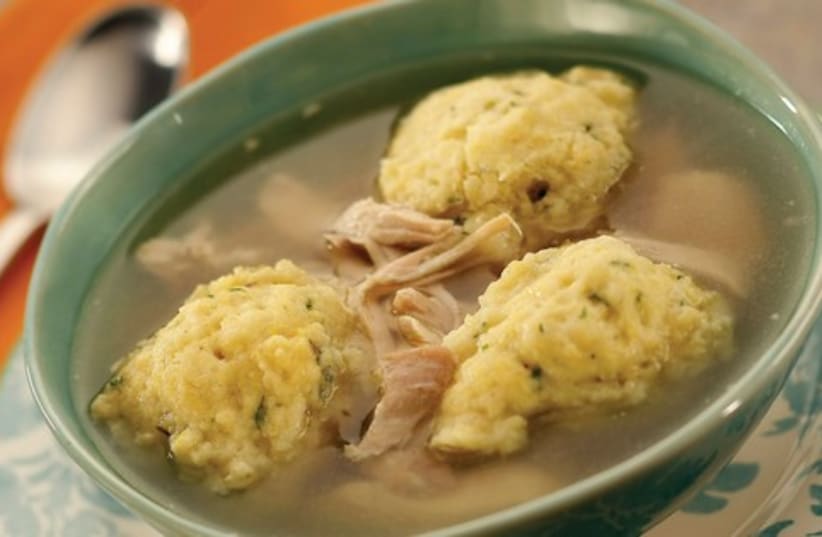Stewing hen with cornmeal parsley dumplingsThe dumplings in this entree, which are made with corn kernels in addition to cornmeal, are served in a rich broth with the meat of a whole chicken. The recipe is from Heartland.Author Marcia Adams notes: “Some cooks prefer to thicken the boiling broth slightly with a cornstarch and water mixture before adding the dumplings; that is entirely up to you and how thick you want the broth.Start with 3 tablespoons of cornstarch and 1⁄2 cup water and go from there.” If you are using the thickener, stir the mixture into the simmering broth and return it to a simmer, stirring, before adding the dumplings.Adams prefers the succulent flavor of a mature stewing hen for making the broth but you can use an ordinary chicken.Adams gives this tip for cooking dumplings: They should be cooked without peeking. In another dumpling recipe she advises: “Do not lift the cover during the cooking period or the dumplings will fall.”Makes 4 servingsa 1.3 to 1.8-kg (3- to 4-pound) chicken or stewing hen, cut into serving pieces 1 celery stalk with leaves, cut into thirds 1 carrot, peeled and quartered 1 medium onion, peeled and quartered 1 bay leaf 1⁄2 cup parsley sprigs 6 peppercornsDumplings: 1 cup water 1⁄2 cup yellow cornmeal 1⁄2 tsp. salt 1⁄2 tsp. freshly ground black pepper1 egg, lightly beaten 1⁄2 cup all-purpose flour 1 tsp. baking powder 1 cup canned corn, drained (about 200-225 gr. or 7-8 ounces) 2 Tbsp. finely minced fresh parsleyPlace chicken in a large stewing pot. Add celery, carrot, onion, bay leaf, parsley, peppercorns and water to cover; bring to a boil. Reduce heat to a simmer and cook, covered, until chicken is tender, about 1 to 11⁄2 hours. Strain broth and discard vegetables, then return broth and chicken to pot and bring back to a boil while you prepare the dumplings.Dumplings: In a medium saucepan, combine the water, cornmeal, salt and pepper and bring to a boil.Cook and stir until thickened; remove from heat. Stir some of the hot mixture into the beaten egg, then stir the egg mixture back into the hot cornmeal. In a medium mixing bowl, combine the flour and baking powder. Add the cornmeal mixture and beat well, then stir in the corn and parsley.Drop the dumpling batter by tablespoons into the boiling broth. Cover the pan tightly and simmer for 12 to 15 minutes without peeking.Serve the chicken and dumplings on a deep platter or in a shallow tureen with some of the broth spooned over them.Faye Levy is the author of Sensational Pasta and of the Fresh from France cookbook series.
Food: A nostalgic dish
Warming dishes like dumplings evoke nostalgia wherever they are made.

Stewing hen with cornmeal parsley dumplingsThe dumplings in this entree, which are made with corn kernels in addition to cornmeal, are served in a rich broth with the meat of a whole chicken. The recipe is from Heartland.Author Marcia Adams notes: “Some cooks prefer to thicken the boiling broth slightly with a cornstarch and water mixture before adding the dumplings; that is entirely up to you and how thick you want the broth.Start with 3 tablespoons of cornstarch and 1⁄2 cup water and go from there.” If you are using the thickener, stir the mixture into the simmering broth and return it to a simmer, stirring, before adding the dumplings.Adams prefers the succulent flavor of a mature stewing hen for making the broth but you can use an ordinary chicken.Adams gives this tip for cooking dumplings: They should be cooked without peeking. In another dumpling recipe she advises: “Do not lift the cover during the cooking period or the dumplings will fall.”Makes 4 servingsa 1.3 to 1.8-kg (3- to 4-pound) chicken or stewing hen, cut into serving pieces 1 celery stalk with leaves, cut into thirds 1 carrot, peeled and quartered 1 medium onion, peeled and quartered 1 bay leaf 1⁄2 cup parsley sprigs 6 peppercornsDumplings: 1 cup water 1⁄2 cup yellow cornmeal 1⁄2 tsp. salt 1⁄2 tsp. freshly ground black pepper1 egg, lightly beaten 1⁄2 cup all-purpose flour 1 tsp. baking powder 1 cup canned corn, drained (about 200-225 gr. or 7-8 ounces) 2 Tbsp. finely minced fresh parsleyPlace chicken in a large stewing pot. Add celery, carrot, onion, bay leaf, parsley, peppercorns and water to cover; bring to a boil. Reduce heat to a simmer and cook, covered, until chicken is tender, about 1 to 11⁄2 hours. Strain broth and discard vegetables, then return broth and chicken to pot and bring back to a boil while you prepare the dumplings.Dumplings: In a medium saucepan, combine the water, cornmeal, salt and pepper and bring to a boil.Cook and stir until thickened; remove from heat. Stir some of the hot mixture into the beaten egg, then stir the egg mixture back into the hot cornmeal. In a medium mixing bowl, combine the flour and baking powder. Add the cornmeal mixture and beat well, then stir in the corn and parsley.Drop the dumpling batter by tablespoons into the boiling broth. Cover the pan tightly and simmer for 12 to 15 minutes without peeking.Serve the chicken and dumplings on a deep platter or in a shallow tureen with some of the broth spooned over them.Faye Levy is the author of Sensational Pasta and of the Fresh from France cookbook series.